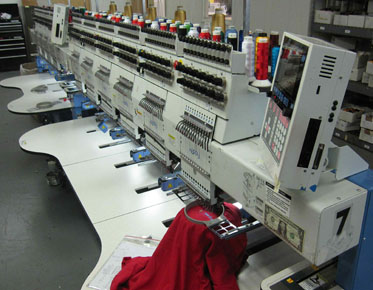Common Challenges in Embroidery Digitization and How to Overcome Them
Embroidery is a timeless art form that has evolved with technology. Today, digital embroidery machines have made it easier than ever to transform digital designs into intricate stitched patterns on fabric. However, like any creative process, embroidery digitization comes with its fair share of challenges. In this comprehensive guide, we will explore the common hurdles faced in embroidery digitization and provide practical solutions to overcome them. Whether you're a seasoned digitizer or a beginner looking to delve into this craft, understanding these challenges and their solutions will help you achieve better results in your embroidery projects.
Understanding Embroidery Digitization
Before we dive into the challenges, let's clarify what embroidery digitization entails:
Embroidery digitization is the process of converting digital artwork or designs into a format that can be read and executed by an embroidery machine. This involves creating a digital embroidery file that contains instructions for the machine to follow, including stitch types, colors, and sequences.
Now, let's explore the common challenges faced in this intricate process.
Challenge 1: Complexity of Design
Challenge: Complex designs with intricate details can be challenging to digitize accurately. Maintaining the design's integrity while simplifying it for embroidery can be a delicate balancing act.
Solution:
● Simplify the Design: Start by simplifying the design. Remove excessive details that may not
translate well into embroidery. Focus on the essential elements that capture
the essence of the design.
● Use the Right Stitch Types: Choose stitch types that work best for complex details. For fine lines
and small details, consider using a satin stitch. For larger areas, fill
stitches or tatami stitches can provide a smooth finish.
● Test and Refine: Don't be afraid to experiment and test your design on scrap fabric or a sample piece. Make adjustments as needed to ensure the final embroidery looks as close to the original design as possible.
Challenge 2: Color Matching
Challenge: Achieving accurate color matching in embroidery can be tricky, especially when translating digital colors into thread shades.
Solution:
● Create a Color Chart: Before digitizing, create a color chart that matches digital colors to
thread colors. This serves as a reference guide during digitization.
● Use Pantone or Thread Color
Guides: Pantone color guides or thread color guides
from your embroidery machine manufacturer can help you choose the right thread
shades.
● Regularly Calibrate Your Machine: Ensure that your embroidery machine is regularly calibrated to maintain accurate color reproduction.
Challenge 3: Stitch Density
Challenge: Stitch density refers to the number of stitches in a given area. Balancing stitch density is crucial to avoid overcrowding or gaps in the embroidery.
Solution:
● Adjust Stitch Length: Experiment with stitch length to control stitch density. Shorter
stitches increase density, while longer stitches reduce it. Adjust as needed
for different parts of the design.
● Use Underlay Stitches: Underlay stitches provide stability to the embroidery by preventing
fabric puckering and improving coverage. They are especially important in
high-density areas.
● Test on Different Fabrics: Stitch density can vary depending on the fabric used. Test your design on different fabrics to ensure it looks good on all materials you plan to use.
Challenge 4: Size Considerations
Challenge: Resizing a design can lead to distortion or loss of detail. Maintaining the design's proportions while resizing is a common challenge.
Solution:
● Design in Vector Format: Whenever possible, work with vector designs that can be easily resized
without loss of quality.
● Digitize Multiple Sizes: If you need the same design in various sizes, consider digitizing each
size separately. This ensures that each version is optimized for its intended
size.
● Maintain Aspect Ratio: When resizing, always maintain the aspect ratio (proportions) of the design to prevent distortion. Most digitization software allows you to lock the aspect ratio during resizing.
Challenge 5: Lettering and Fonts
Challenge: Embroidering text, especially small lettering, can be challenging due to the limitations of thread thickness and legibility.
Solution:
● Choose Appropriate Fonts: Select fonts that are designed for embroidery. These fonts are
optimized for legibility at small sizes and often have fewer fine details.
● Adjust Letter Spacing: Adjust the spacing between letters (kerning) to ensure legibility. Letters
that are too close together can be hard to read.
● Use Open Fonts: Open or single-line fonts are specifically designed for embroidery. They consist of single lines instead of filled shapes, making them ideal for small lettering.
Challenge 6: Machine Compatibility
Challenge: Not all embroidery machines are created equal. Compatibility issues can arise when transferring digital files to different machine models.
Solution:
● Know Your Machine: Understand the capabilities and file format requirements of your
specific embroidery machine.
● Use Common File Formats: Stick to common embroidery file formats like .dst, .pes, or .exp, which
are widely supported by various machines.
● Test on Your Machine: Always test your digitized design on your machine to ensure compatibility and make any necessary adjustments. Challenge 7: Quality Control
Challenge: Ensuring consistent quality across multiple embroidery runs or different machines can be a challenge.
Solution:
● Document Settings: Maintain detailed records of your digitization settings, including
stitch types, colors, and densities. This documentation can serve as a
reference for future runs.
● Perform Quality Checks: Regularly inspect embroidered samples for quality. Check for thread
breaks, tension issues, and color discrepancies.
● Maintain Your Machine: Regular maintenance of your embroidery machine is essential for consistent quality. Follow the manufacturer's guidelines for upkeep.
Challenge 8: Mastery of Digitization Software
Challenge: Learning and mastering embroidery digitization software can be time-consuming and may require a steep learning curve.
Solution:
● Invest in Training: Consider taking courses or tutorials on embroidery digitization
software to accelerate your learning curve.
● Practice Regularly: The more you practice, the more proficient you'll become. Experiment
with different designs and techniques to build your skills.
● Seek Support: Join embroidery forums or communities where you can ask questions, share experiences, and learn from others in the field.
Challenge 9: Cost and Time Constraints
Challenge: Embroidery digitization can be time-consuming, and the cost of digitization software and equipment can be a barrier for some.
Solution:
● Plan Ahead: Allocate sufficient time for digitization in your project timelines to
avoid rushing the process.
● Budget Wisely: Factor in the cost of digitization software and equipment when
starting an embroidery project. Consider it an investment in your craft.
● Outsource Digitization: If time or budget constraints are significant, consider outsourcing digitization to professional digitizers who can provide high-quality results.
Challenge 10: Keeping Up with Trends
Challenge: The embroidery industry is continually evolving, with new techniques and trends emerging regularly. Staying up-to-date can be a challenge.
Solution:
● Continual Learning: Dedicate time to stay informed about the latest trends, techniques, and
software updates in the embroidery industry.
● Attend Workshops and
Seminars: Participate in workshops, seminars, and
industry events to learn from experts and network with fellow digitizers.
● Experiment and Innovate: Don't be afraid to experiment with new techniques and designs to stay ahead of the curve.
Conclusion: Mastering Embroidery Digitization
Embroidery digitization is a rewarding craft
that allows you to transform digital designs into beautiful stitched creations.
While it comes with its share of challenges, understanding these obstacles and
implementing the provided solutions will help you overcome them with
confidence. Whether you're digitizing complex designs, working with intricate
details, or perfecting your lettering, continuous learning and practice will
ultimately lead to mastery in the art of embroidery digitization. So, embrace
the challenges, enjoy the creative process, and produce stunning embroidered
works of art.



